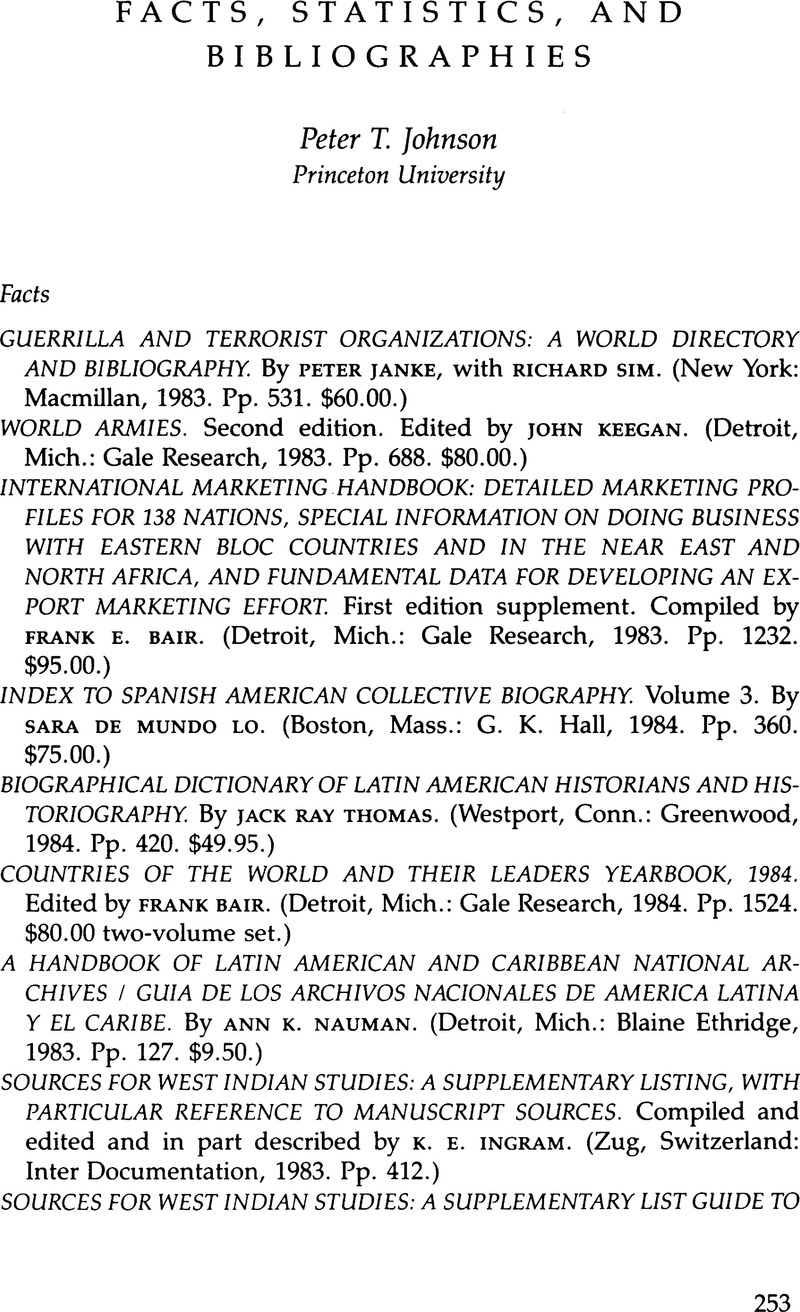No CrossRef data available.
Article contents
Facts, Statistics, and Bibliographies
Review products
Published online by Cambridge University Press: 12 October 2022
Abstract

- Type
- Review Essays
- Information
- Copyright
- Copyright © 1987 by the University of Texas Press
References
Notes
1. A fuller discussion of these criteria can be found in Peter T. Johnson, “Bibliography: Current Practices and Future Trends,” LARR 18, no. 1 (1983):254–55.
2. Still basic is Luigi Einaudi's and Herbert Goldhamer's “An Annotated Bibliography of Latin American Military Journals,” LARR 2, no. 2 (1967):95–122. The Latin American Microform Project (LAMP) is sponsoring a selective microfilming project for these titles.
3. Sara de Mundo Lo received the José Toribio Medina Award in 1983 from the Seminar on the Acquisition of Latin American Library Material (SALALM) for an earlier volume.
4. The Cuban Archivo Nacional contains an impressive section of private-sector papers that reverted to the government when their owners were exiled. A separate card catalogue lists these materials. As of 1979 (when I visited this archive), no printed guide existed. Government agencies are scheduled to transfer their records after thirty years to the Archivo Nacional.
5. For example, see the Research Guide to Andean History: Bolivia, Chile, Ecuador, and Peru (Durham, N.C.: Duke University Press, 1981); Research Guide to Central America and the Caribbean (Madison, Wis.: University of Wisconsin Press, 1985); and David P. Werlich, Research Tools for Latin American Historians: A Select, Annotated Bibliography (New York: Garland Publishing, 1980).
6. In addition, see Josefina Zoraida Vázquez and Pilar Gonzalbo Aizpuru, Guía de protocolos del Archivo General de Notarias de la Ciudad de México, año 1836 (Mexico City: Centro de Estudios Históricos, Colegio de México, 1985), which contains 2,870 entries representing 10,964 individuals, of which 2,168 are women.
7. For example, the UN's Yearbook of National Account Statistics (for 1957 on) and Demographic Yearbook (for 1948 on); the Food and Agriculture Organization's Production Yearbook (for 1958 on); the International Monetary Fund's Balance of Payments Yearbook (for 1938 on), and International Financial Statistics (for 1948 on).
8. BorderLine is a consortium of libraries along the U.S. and Mexican border that built a comprehensive on-line information retrieval service with NEH support. As of spring 1987, the database had over sixty-two hundred items for the social sciences, humanities, and sciences. It will appear in book form.
9. Dolores M. Martin, Editor of HLAS, and Barbara Valk, Editor of HAPI, received the José Toribio Medina Award from SALALM for their contribution to Latin American studies.
10. Interviews in 1983 and 1985 with national library administrators in Chile and Brazil revealed that literature produced outside legal-deposit commercial channels by political parties, feminist groups, and human rights organizations (among others) was not collected because these libraries had no legal obligation to do so or because no space existed for such items. In contrast, see the Bio-bibliografía Boliviana (1963–), which is compiled annually by Werner Guttentag and published by Los Amigos del Libro in La Paz, Bolivia. Guttentag received the José Toribio Medina Award in 1985.
11. Volume 1 of the Bibliografía jurídica de América Latina (1810–1965) was published in 1969 in Santiago by Editorial Jurídica de Chile; Volumes 3 and 4 are forthcoming.
12. For Nicaragua, see Por el rescate democrático de Nicaragua (published in San José, Costa Rica) and DC Info (published in Brussels); for Paraguay, Síntesis (published in Mexico City); and for Colombia, M-19 (published in Mexico City).
13. Interview with María Lastayo, former head of selection and exchange at the Biblioteca Nacional “José Martí,” in Havana, 27 March 1979.
14. The Latin American Microform Project (LAMP) is one of the most successful institutional cooperative networks in collection development and preservation.


